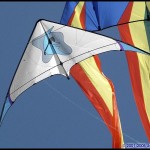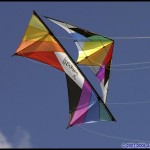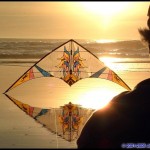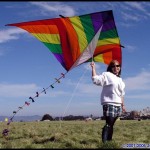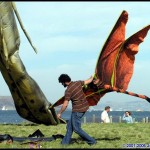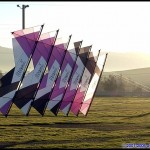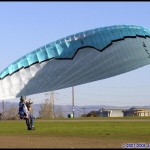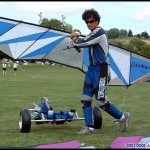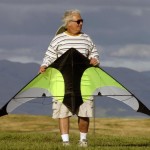 I first ran across John Chilese’s name as a result of a Google-search… I’d been flying SLKs and dualies on my own for years, but was finally getting interested in “organized” kiting… Time to find out what was on the net having to do with kites. Of course, I’d no idea that the ENTIRE WORLD of kites was out there on one website – or at least that’s the way it appeared when I first got to Chilese’s KiteAddiction” site… I was “lost” for a couple of days there… I’m sure I’m not the only person that happened to, either… Sometime later, it turned out that both John and I would attend Dave Shenkman’s Kite Party # I, so I emailed John that I had some kites that he might add to his albums.. Would he be interested in photographing them? After his acceptance, we took some of the “collectables” along to Huntington Beach…
I first ran across John Chilese’s name as a result of a Google-search… I’d been flying SLKs and dualies on my own for years, but was finally getting interested in “organized” kiting… Time to find out what was on the net having to do with kites. Of course, I’d no idea that the ENTIRE WORLD of kites was out there on one website – or at least that’s the way it appeared when I first got to Chilese’s KiteAddiction” site… I was “lost” for a couple of days there… I’m sure I’m not the only person that happened to, either… Sometime later, it turned out that both John and I would attend Dave Shenkman’s Kite Party # I, so I emailed John that I had some kites that he might add to his albums.. Would he be interested in photographing them? After his acceptance, we took some of the “collectables” along to Huntington Beach…
And over the years, John and I’ve had some interesting conversations, both face-to-face and via email. And in the whole deal, I flatter myself to think we’ve become friends in the process. So when Kitelife began to feature great “kite photographers,” in each issue, John’s name popped into mind immediately. Well – we’re far enough into featuring Killer Kite Shooters now that John’s work can stand on its own…
Herewith, we’re pleased to present – John Chilese, the Kite-Shooter – and “Godfather,” the man…
Okay John, let’s start with the easy stuff first. When and how did you originally get started in kiting?
In July of 2001, I was on a rare Chilese family reunion in Carlsbad, CA. Bambi and I were walking one afternoon when she stopped and said, “You’re going to buy me a kite.” We were standing in front of a kite store. We came out with a Team Hawaiian which I was shocked to find cost more than my tennis rackets. Worse, there were no instructions. We couldn’t get it to fly until Bambi said, “I think we need to move the strings around (bridle)”, we did and it flew.
How did you make the transition from a guy who was merely interested, into the true “kite addict” we all know you to be now? What really got you “hooked,” and then spurred you on?
When the Hawaiian didn’t fly the next day, we went back and bought a Beetle. At that point, I was hooked. I realized then, that there were lots of different kinds of kites, but not a lot of good information about choosing the right one for your local conditions. After a lot of searching, I found out about used kites through the Kite Classifieds. Back then, used kites were cheap. I bought a Vented AirFX for $40, and many were under $75. There were all these great kites available at rock bottom prices. Bambi recently commented to me, “If you hadn’t taken nice pictures of the old kites, I’d still be able to get them at a low price.” It seems I made buying old kites fashionable.
And how did you get interested in doing your famous “kite portraits?” What got you started shooting and what fueled the fire that made you excel at Kite Photography?
When I started in kites, I wanted to know everything. There were very few pictures of kites, and fewer still of kites flying. I remember seeing several pictures by Hoy Quan. Remember, in the 90s, pictures were small on the internet due to dial up speeds. And digital cameras were much lower resolution. I explained to Bambi all the small pictures and she said, “You’ve got a digital camera, go take some pictures.” So I did.
Can you give us an idea of the process you went through in discovering how to photograph kites? How did you start out, and what ways have your thoughts regarding your “photo style” changed and developed over the months and years?
It’s more about looking at pictures I’ve taken and seeing what I didn’t like. Trees and the ground make a poor background. Water and the sun are good. That sort of thing. Kitelife actually published an article I did explaining my “process”. You can find it in Issue 33.
Okay – over time, you’re busy becoming a darned decent competition pilot, a kite collector with a pretty decent accumulation, and folks are beginning to think of you as the Rembrandt of Kite photography. Let’s touch on each of these – one at a time…
First, explain how you made the transition from recreational pilot to competitor. What initially drove you to compete, and what kept you active in that aspect of the sport over the years? Were there people who urged you, or was it simply a case of testing your skills against the other local pilots? Who were the people who influenced you in your competition quest?
Actually, I’ve always been competitive: wrestling, tennis, racquetball, handball, softball, basketball, you name it, I competed. So naturally I started competing in kites right away. I begged and paid a late fee to compete at Berkeley 30 days after I bought my first kite. I entered Novice and flew the Team Hawaiian in very strong winds and took 8th out of 9. I only flew NIP and didn’t even know about the “showoff” time after the 3 figures. I was fortunate enough to live in the Bay Area where BASKL had all their events within an hour’s drive. BASKL is a great organization. I use to believe that only the good flyers competed. How naïve was that? As far as people who influenced and helped, just go read the list of competitors at any BASKL event. It was more family than foes.
At the same time, you began to acquire some noteworthy kites – some just to fly for fun, some specifically to use for competition, and a few just to “Collect.” How did all this occur? Did it just happen, or were you working to a plan? And how many kites does the “Chilese Collection” contain at present?
Barring a few recent additions not yet added, Bambi and I have this collection.
I also am awaiting 2 very special kites by Wayne Knott and Marty Sasaki. As far as working to a plan: sadly, I never have a plan for anything. I sort of let things happen. I have an appreciation of kites from an aesthetic and craftsmanship point of view. So if a kite is beautiful and/or flys well, I’ll buy it.
And when you decided to “get serious” about kite photography, what changes did you begin to make to your equipment, software, and your shooting philosophy – and why? Take us through the scenario, please…
I use to do a lot of film photography of pretty women’s faces. Hey, it was my hobby so I thought it was a great choice. When I came home to Bambi one day and all my photos of women were turned to the wall I realized I wouldn’t be doing that anymore. So I knew the basics, and cameras have come so far that I just started shooting kites the same way I shot women’s faces. I would fill the screen with the subject. If that’s your subject, why not make it as much of the picture as possible? It also seemed natural to take pictures of kites flying, not leaning against a fireplace made of stone or brick. I never considered myself an artist, artists create beauty. Photographers recognize beauty. Instead of getting too longwinded here about shooting and software, I’ll just ask the reader to go read the article I referenced above. 99% of it is still how I shoot. It must work, a lot of the photographers shooting kites are following those steps. I’d like to think I was the teacher to these people.
I first ran into the Chilese Kite Photo Website through a Google-search for “Kite Photos.” What an AMAZING collection of pictures, John! How did all that come about? And please give us an idea of what Michael Teator’s “KiteAddiction” site meant to you at the time.
Michael had this amazing kite web ring, with dynamic websites. I didn’t even know what they were but web designers would write to me about the site, not my pictures, the site. Now, dynamic websites like Michael made for myself and others would cost $100/month and that’s just to host it. Michael still owns the domain www.chilese.com. I do miss that domain name. He’s holding it for me. Michael, my deep thanks. Now, for the money, it’s hard to beat Webshots although being limited to 3000 pictures, means I have to delete a photo every time I post one.
I don’t believe for a moment that the “camera makes the shooter.” Rather, I think a competent photographer selects the best “tools” he can afford, and uses them to create fine photos. Now – just because everyone wants to emulate “The Master” – what camera(s) have you been using over the years? And have you any additional comments about any other shooting “tools of the trade?”
My first digital camera was a Nikon 900s 1.3MP which I still have. I published a book during my first year and all the photos in the book are from that camera. My thanks to the small group who plopped down $50 for an unknown product. I earned about 10¢/hour on that project and the books cost $36 each to print. My second digital camera was my son’s Fuji 3800 3MP. Most of the pictures on my Webshots site were taken with that one. Currently, I’m using an Olympus 8080 8MP. The new cameras are so good, it’s hard to go wrong if you spend at least $400. Digital still isn’t as good as film for the purist, but it’s close enough for me. I’m lazy and just shoot on automatic/sport mode, take lots of pictures and know what setups work for the way I shoot.
And what about the digital “post-processing” part of the photo game? What software package(s) have you used over the years, and how much photo manipulation do you actually do?
I live on Photoshop. Every picture I post has gone through that software. Digital cameras don’t have the dynamic range of film yet. I typically, crop, rotate, resize, and use auto-color or auto-levels. Sometimes I will do dodge and burn. And sometimes, I’ll do composite layering to move objects around. Some photos have 2-3 hours on them. Most photos have 2-3 minutes in post processing. Bambi is very familiar with how the back of my head looks as I spent so much time in front of the computer.
Finally, here’s your chance to list a few choices. Care to comment about your:
Your favorite kite-photos (yours and/or others)?
I’ve begun working on getting the pilots into more of the pictures and to show beginners with their kites to encourage them. They get a kick out of seeing themselves with their kite on the internet. As far as kite photos, I’ve seen pictures by many people I enjoy. A sleeper out there is Steve Brown. If he ever buys a decent camera, watch out. As far as consistently good photos of kites, Randy Greenway. I’d have to call him my best unofficial student. As far as my photos, you’re including some I like.
Some of your favorite performances (yours and/or others)?
I did have an EIB flying to Roxanne from Moulin Rouge at one of the BASKL events I felt really good about. As far as others, there are so many flyers above me I just watch them all and think what would have happened if I practiced more and shot less. When Brian Champie and Miguel Rodriguez sometimes nail their MPB, it’s moving.
Your favorite kiting events?
Berkeley Kite Festival (which I will miss this year), Dave Shenkman’s Kite Party in February and the Chico Fun Fly/Mojo Workshop.
Some of your favorite pilots (both for photos and generally)?
Jim Byrne has probably been in more of my favorite kite pictures than anyone. The whole series of the wet Masquerade shots is a story in itself. As far as graceful pilots, John Welden is Fred Astaire. As far as athletic, Uly Villanueva. Technically proficient, Ron Graziano and Mark Reed. Indoors, Lam Hoac. The list could go on a long time.
Some of your favorite kiting friends and personalities?
Of all the sports I’ve been associated with, kiting has the highest group of friendly, helpful people. Even people I started out not liking, have become people I enjoy for a variety of reasons. The list would be too long and I would forget too many.
Thanks, John! While we’re at it, it’s probably no surprise that you’ve done fairly well in Kite-photo competitions over the years. How many have you won, and which contests(s) have really pleased you?
I actually only “won” one competition for kite photos in France a few years ago, and even then, by just one point. I purposely have avoided entering any kite photo competitions except some of the friendly ones on the GWTW Forum. It’s a subjective area, similar to kite comps. And I quit competing in them after a few years as I was getting too serious about the outcome.
I’ve had the great good fortune to attend some of the same events along with you, and have enjoyed having my kites photographed… except I never quite adapted to your “HOLD IT RIGHT THERE!” shooting mandate. How did you get from the fairly simple concept of taking the occasional kite-shot into being “the man” who chronicles entire events?
I was in the right place at the right time. High speed internet started allowing larger photos. Digital cameras and their optics got a lot better. And on the West Coast, there is an unreal concentration of flyers, and therefore kites available for me to shoot locally. People started coming up to me to take pictures of their new kites. It just kind of snowballed from there.
And, somewhere along the way… you became “The Godfather!” How did all that come about? Who first called you “The Godfather,” and who said it often enough to make sure the appellation stuck? And, do folks outside of Kiting call you “The Godfather” too?
Laurent Moll, who always kicked my butt in comps until he retired, called me that one day after I taught him how to axel. He simply said, “Thank you Godfather.” I took it as kidding, but somehow people started using it and it stuck. I never promoted it, although I have been told I look pretty ominous in a pin-striped suit. I am not the Godfather anywhere except on the kite field and to my real God daughter Chaynie.
So you’ve been very active in several different aspects of kiting for a good bit, and you have also agreed to take on a few extra tasks for the common good of kiting from time to time…
How did you go about becoming the GWTW Forum Moderator? What has that meant to you?
Dan Whitney, Steve Hall and Chris Miller thought I would be a good moderator as I was living on the Forum way too much anyway. It actually got too consuming and I turned over my moderator duties to a better man. He runs a much tighter, cleaner Forum than I did. I guess people know me mostly from the Forum, but that’s because I post more than anyone, not due to my moderation skills, of which Dodd Gross would tell you I had not enough.
Did you accept the invitation to become part of the BASKL Board? If so, what did you find satisfying about that position, and what do you feel you accomplished?
I turned down a position on the BASKL board due to time constraints. Susan Skinner politely asked, but I had to decline.
And how did you happen to get involved in becoming a “Creator of Calendars” and designing kite sail patterns, and developing kite “info charts,” and starting the occasional “contest,” etc. Is that something you just like to do?
Bambi says I always have to be the center of attention. Maybe she’s right. The contests are because I love games. Life is a game. But more than one person gets to win. Kite patterns and logos have been used by Paul Shirey, Dennis Fishback and a few others. I’m most proud of my Aerostar logo, although the Dorsal logo is the prettiest. By the way, there was no money in this, but Paul did give me a hat.
And what other little kiting “chores” have you tackled that we didn’t even know about?
I’m most proud of the hundreds of people I have taught to fly sport kites, including a few schoolrooms worth of kids. I think it’s what helped BASKL see fit to give me the Tom Turner Spirit Award two years ago. The base of that annual award contains some mighty nice company to be honored with.
Now we’re going to switch from Sir Chilese, confirmed Kite-Addict – to John Chilese, the man. You’ve recently gone through a couple of major milestones in your life with retiring (after how many years?), a move from Cupertino to Las Vegas, and the acquisition of a home down there. How do you feel about all that? Care to expound, or complain, or “sum up?”
After working for over 30 years, retiring is sort of scary. Owning a house after 16 years of apartment living is exciting if Bambi is involved. I lived in Phoenix for a few decades so the heat of Las Vegas is familiar.
What are your plans for the future now? Will you draw back from the kiting community a bit, or does it mean you’ll have more time to attend more kiting events and festivals? Will you buy a motor home and travel the country in search of the perfect kite-photo? Do you plan to spend some time buggying with Corey Jensen? Play a little Golf or Tennis, or (God Forbid) spend some time at the tables in Vegas? What’s in store for you?
I will be working at least part time in the near future just to keep my brain from turning to jelly. I will still go to a few kiting events, but those will be fun flys, not comps. I will sadly, be taking less kite photos just from the availability factor. There aren’t as many flyers/kites in the Las Vegas area. Although there are a lot more buggiers, Mr. Jensen included. I think my tennis days are over, although I still play basketball and pickleball on occasion. And I do sometimes gamble, although it should really be called aconstantdrainofyourmoney.
I’ve heard through the grapevine that you’re something of a game-player and a collector. So, how did kiting fit in with all your other hobbies?
Well, I still buy board games, just at a much slower rate. I probably have over 100 quality boards, not Monopoly and Risk, mostly German designed family strategy games like Carcassone. Kiting doesn’t fit other hobbies, it’s more of an additive.
And through all this, you’ve been lucky enough to have been married to the marvelous Bambi – the “Ultimate Kite-Babe.” How does Bambi view all of this “life changes” stuff? And is she as pleased to have been a part of the kiting community as you are? And what plans does she have for the future? (Let BAMBI answer this one, John…)
Are you kidding, she will be by my side during this entire interview. I am very lucky to have a wife who enjoys kiting and cares for me enough to let me do what I enjoy. BAMBI SAYS: “After 16 years of apartment living, John has bought me the home of my dreams. And now I’m looking for the boat of my dreams. We will still be involved in kiting and from time to time will see our kiting friends at different events. I look forward to John flying his kites off the back of our new boat.”
Finally, a couple of “generic” kiting questions here.
Who influenced you strongly in your explorations of the different aspects of kiting?
In no particular order: Brian Champie, Dan Whitney, Jim Byrne, Steve Brown, BASKL one and all, and Bambi. They all made me a better kiter, for a variety of reasons.
Do you think kiting will ever become a mainstream sport? If not, why not? If so, what can we fellow kiters do to help?
No I don’t think kiting will become a mainstream sport. Kiting takes up a lot of room for one person. It’s land inefficient. If you want to help, be friendly and offer your services to the new people you see at your local kite field. Teach people how to fly on your good kites, not those beaters you keep for them to bash. I’ve taught newbies on a Vapor (lost one sail). Whatever I’m flying is what they learn on. Take their picture with the kite and send it to them in an email or post it so they can show their friends. Have business cards of your favorite kite store to give out in case people show an interest in sport kites. If someone could teach Tom Cruise to fly and he were filmed doing it, this sport would be huge in one month. I don’t know if that’s a good thing.
And on a personal note, please support the one person kite shops/makers. Kiting is one of the few areas where the best kites are made in North America by discerning craftspeople like Ken McNeill, Paul Shirey, Lam Hoac, Peter Betancourt, Wayne Knott, Shawn Tinkham and Ed Shenk. So the next time you are thinking about a new kite, help keep a tradition alive and local.
John, Thanks SO much for this interview with Kitelife! And while we’re at it, thanks also for helping Kitelife whenever we’ve asked – including your very generous offer to allow Kitelife.com to use your fine images whenever we wished. You’ve been a terrific friend, a superb ambassador for the sport, and a gracious gentleman to everyone on the flying field. We at Kitelife, and all who know you, wish you continued joy and delight in whatever you choose to do with your retirement – and that most specifically includes kiting. Good Luck and Godspeed, Godfather!





